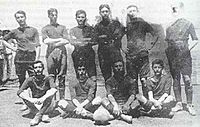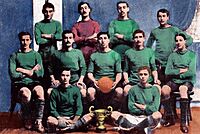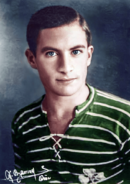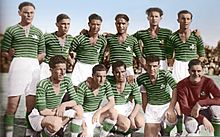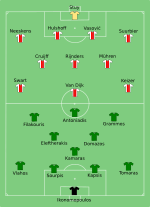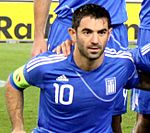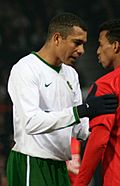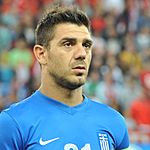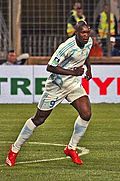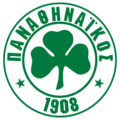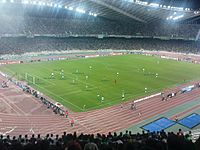Panathinaikos F.C. facts for kids
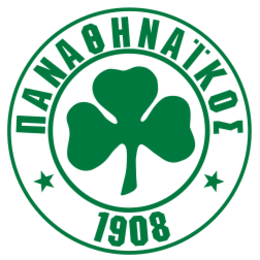 |
||||
| Full name | Παναθηναϊκός Αθλητικός Όμιλος Panathinaïkós Athlitikós Ómilos (Pan-Athenian Athletic Club) |
|||
|---|---|---|---|---|
| Nickname(s) | Trifýlli (The Shamrock) Prássinoi (The Greens) | |||
| Short name | PAO (Greek: ΠΑΟ) | |||
| Founded | 3 February 1908 as POA 1910 as PPAO (Later PAO in 1924) |
|||
| Ground | Apostolos Nikolaidis Stadium Athens Olympic Stadium |
|||
| Capacity | 16,003 69,618 |
|||
| Owner | Giannis Alafouzos | |||
| President | Giannis Alafouzos | |||
| Head coach | Rui Vitória | |||
| League | Super League Greece | |||
| 2024–25 | Super League Greece, 2nd of 14 | |||
|
||||
Panathinaikos Football Club, often called Panathinaikos or PAO, is a professional football team from Athens, Greece. Its full name means "Pan-Athenian Athletic Club."
The club was started in 1908 by Georgios Kalafatis as "Podosfairikos Omilos Athinon" (Football Club of Athens). Panathinaikos plays in the Super League Greece, which is the top football league in Greece. It is one of the most successful clubs in Greek football. It is also one of only three clubs that have never been relegated from the top division.
Panathinaikos has won many major titles. These include 20 Greek Championships and 20 Greek Cups. They have won both the league and cup in the same season eight times, which is called a Double. They also have 3 Greek Super Cups. In the 1963–64 season, they won the Greek championship without losing a single game.
Panathinaikos is the only Greek team to reach the final of the UEFA Champions League (Europe's biggest club competition) in 1971. They lost to Ajax 2–0. They also reached the semi-finals twice (1985 and 1996) and the quarter-finals four times (1992, 2002, 1988, 2003). They won the Balkans Cup in 1977. Many studies show that Panathinaikos is the second most popular football team in Greece. The club is also a member of the European Club Association.
They play their home games at the Leoforos Alexandras Stadium, which is their traditional home, and sometimes at the Athens Olympic Stadium. Panathinaikos has a big rivalry with Olympiacos. Their matches are known as the "Derby of the Eternal Enemies."
Contents
- Club History: Early Years & Growth
- Challenges and Triumphs (1930s-1970s)
- Modern Era: Professional Football & Fan Ownership
- Club Identity: Crest & Colours
- Home Grounds & Training Facilities
- Club Finances & Ownership
- Panathinaikos Supporters
- Club Records & Statistics
- Club Honours (Trophies)
- European & Worldwide Achievements
- Current Players
- Former Players
- Panathinaikos & the Greece National Team
- Club Staff
- Club Leadership
- Images for kids
- See also
Club History: Early Years & Growth
Panathinaikos was founded on February 3, 1908, by 17-year-old athlete Giorgos Kalafatis. He left his old club because they stopped their football team. Many other athletes joined him to create the "Podosferikos Omilos Athinon" (Football Club of Athens). Their goal was to make football more popular in Athens and connect with European football.
The first president was Alexandros Kalafatis, Giorgos's brother. The team's first home was on Patission Street. They even brought in John Cyril Campbell, an athlete from Oxford University, as their coach. This was the first time a foreign coach worked for a Greek team. Konstantinos Tsiklitiras, a famous Greek athlete, played as goalkeeper.
In 1910, the club changed its name to Panellinios Podosferikos Omilos ("Panhellenic Football Club"). They also changed their colors to green and white. By 1914, the club was a top team in Greek football. They won the football tournament in 1915.
In 1918, the team chose the trifolium (shamrock) as its symbol. This was suggested by Michalis Papazoglou. The shamrock represents harmony, unity, nature, and good luck. In 1921 and 1922, the club won the first two championships after World War I.
The club needed a bigger home. In 1922, they got land on Alexandras Avenue. This became the famous Leoforos. On March 15, 1924, the club changed its name one last time to Panathinaikos Athlitikos Omilos (PAO), meaning "All-Athenian Athletic Club." It became a club for many different sports.
In 1926, the Hellenic Football Federation (HFF) was created. Panathinaikos won the Athens championships in 1925, 1926, 1927, and 1929.
Panathinaikos won the championship in 1929–30 without losing a game. This was under coach József Künsztler and with Angelos Messaris as their star player. They famously beat their rivals Olympiacos 8–2. Messaris scored three goals in that game.
Challenges and Triumphs (1930s-1970s)
In the 1930s, the club faced some challenges. However, they won their first Greek Cup in 1940, beating Aris 3–1. During World War II, many players joined the army. Sadly, Mimis Pierrakos was killed.
After the war, Panathinaikos won another Greek Championship in 1949. New star players like Vangelis Panakis and Kostas Linoxilakis joined the team. They won the championship again in 1952–53.
By 1959, the team had won seven of the last eight Athens Championships. In 1959, Mimis Domazos, who would become a legendary captain, joined the team. That same year, the new Alpha Ethniki league started, and Panathinaikos became its first champion.
The Golden Decade of the 1960s
Panathinaikos continued to dominate in the 1960s, winning championships in 1961, 1962, 1964, 1965, 1969, and 1970. They also won two more Greek Cups in 1967 and 1969. During this time, many older players retired, and young talents like Domazos, Antonis Antoniadis, Anthimos Kapsis, Kostas Eleftherakis, and Takis Ikonomopoulos stepped up.
Stjepan Bobek became the coach in 1963. He changed the team's playing style and built a new team with young players. Under him, Panathinaikos won the 1964 Championship without a single loss. This made them one of only two teams to win the Greek Championship undefeated in its modern system.
The Road to Wembley: Puskás Era

In 1971, under the famous coach Ferenc Puskás, Panathinaikos reached the 1970–71 European Cup final. They were the first and only Greek team to do so. They lost 2–0 to Ajax at Wembley Stadium. On their way to the final, they beat teams like Everton and Red Star Belgrade. Key players included captain Mimis Domazos, Anthimos Kapsis, and Antonis Antoniadis, who was the top scorer in the competition with ten goals.
Later that year, Panathinaikos played in the 1971 Intercontinental Cup (because Ajax didn't want to participate). They lost to the Uruguayan club Nacional.
In 1972, Panathinaikos won another Championship. Antonis Antoniadis was again the top scorer with 39 goals, which is still a record in the Greek league.
In 1975, the famous Brazilian coach Aymoré Moreira joined, but he was later replaced by Kazimierz Górski. With Górski, Panathinaikos won the double (league and cup) in 1977. They also won the Balkans Cup that same year.
Modern Era: Professional Football & Fan Ownership
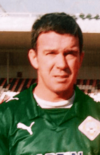
In 1979, Greek football became professional. The Vardinogiannis family bought the football part of PAO. Giorgos Vardinogiannis became president.
The 1980s were successful for Panathinaikos. They won the Greek Cup in 1982. They also won two championships (1984, 1986), four more Greek Cups (1984, 1986, 1988, 1989), and the Greek Super Cup in 1988. The biggest star of this time was Dimitris Saravakos, known as "The Kid."
In the 1984–85 season, Panathinaikos reached the semi-finals of the European Cup. They were knocked out by Liverpool. In 1987–88, they reached the quarter-finals of the UEFA Cup. Dimitris Saravakos was the top scorer in that competition.
The 1990s brought even more success. Panathinaikos won four Greek championships (1990, 1991, 1995, 1996), four Greek Cups (1991, 1993, 1994, 1995), and two Greek Super Cups (1993, 1994).
In 1995–96, Panathinaikos reached the Champions League semi-finals. They beat Legia Warsaw in the quarter-finals. In the semi-finals, they faced Ajax. Panathinaikos won the first game 1–0 away, breaking Ajax's 22-game unbeaten streak. However, they lost the second game 0–3 and were eliminated.
In 2000, Giorgos Vardinogiannis stepped down as president. His nephew Giannis Vardinogiannis took over. Under coach Sergio Markarián, Panathinaikos reached the quarter-finals of the 2001–02 UEFA Champions League. They were eliminated by Barcelona. They won the first game against Barcelona 1–0 at home, but lost the second game 1–3.
In 2002–03, they reached the UEFA Cup quarter-finals. They were eliminated by FC Porto, who went on to win the trophy.
In 2004, under coach Itzhak Shum, Panathinaikos won the championship. They also won the Cup, beating Olympiacos 3–1 in the final, completing the double.
In 2008, due to fan pressure, the Vardinogiannis family reduced their ownership share. New investors joined, and Nikos Pateras became the new president. Panathinaikos brought in expensive players like Gilberto Silva from Arsenal and Djibril Cissé from Marseille.
The 2009–10 season was very successful. Panathinaikos won both the Greek Championship and the Greek Cup. They beat Aris 1–0 in the cup final.
Alafouzos Era: Fan Ownership & Recent Years
In 2012, due to financial problems, the club faced a crisis. Giannis Alafouzos, owner of Skai TV, created a plan for fans to buy shares and help the club. On July 18, 2012, Giannis Vardinogiannis gave his shares to the "Panathinaikos Alliance." This allowed fans to own the club and elect its board of directors and president. Giannis Alafouzos was the first president elected under this new system.
The first season under fan ownership (2012-13) was tough, and the team did not qualify for European competitions.
For the 2013–14 season, Yannis Anastasiou became manager. He built a team with young players from the club's academies and experienced foreign players. Despite doubts, Panathinaikos finished fourth in the league and qualified for the Champions League qualifiers. They also won the 2013–14 Greek Football Cup by beating PAOK 4–1.
In 2018, UEFA decided to ban Panathinaikos from European competitions for three seasons due to financial issues.
In the 2021–22 season, under manager Ivan Jovanović, the team returned to European competitions by finishing fourth. They also won their 19th Greek Cup, beating PAOK 1–0. This ended an eight-year wait for a trophy.
In the 2022–23 season, Panathinaikos had an amazing start, going unbeaten for 16 matches. They finished the regular season in first place. However, in the play-off round, they lost crucial games and finished second, missing out on the league title.
Panathinaikos won the 2023–24 Greek Football Cup by defeating Aris 1–0 in the final. This was their 20th Greek Cup title, and it secured their spot in the 2024–25 UEFA Europa League qualifying rounds. On October 30, 2024, Rui Vitória became the new coach.
Club Identity: Crest & Colours
Crest Evolution
When the team started in 1908, white was their main color. Their first symbol was a football.
In 1911, the colors changed to green and white. In 1918, Michalis Papazoglou suggested the trifolium (shamrock) as the club's emblem. He thought it represented harmony, unity, nature, and good luck. The club wanted a symbol that would represent all of Athens and connect them to the wider world of football.
Georgios Chatzopoulos, a club member and later president, designed the new emblem. For many years, a large green or white shamrock was sewn onto the jersey. When football became professional, the club's crest was created with the club's initials and the founding year, 1908.
Today, green and white are the team's traditional colors. Green stands for health and nature, while white represents virtue. Sometimes white is used as a trim or an alternative color. In the early years, players wore green shirts, white shorts, and green socks. In the 1930s, a design with horizontal stripes became popular. Green has always remained the team's main color.
Shirt Sponsors and Manufacturers
Since 1979, Panathinaikos has had specific kit manufacturers and shirt sponsors.
| Period | Kit manufacturer | Shirt sponsor |
|---|---|---|
| 1979–1980 | Adidas | — |
| 1980 | Puma | |
| 1980–1981 | ASICS Tiger | |
| 1981–1982 | Admiral | |
| 1982–1983 | ASICS Tiger | |
| 1983–1985 | Citroën | |
| 1986–1987 | Interamerican | |
| 1988–1993 | ASICS | |
| 1993–1995 | Kappa | |
| 1995–1997 | Adidas | |
| 1997–1999 | — | |
| 1999–2000 | Motor Oil Hellas | |
| 2000–2001 | Piraeus Bank | |
| 2001–2004 | OTE | |
| 2004–2011 | Cosmote | |
| 2011–2014 | OPAP | |
| 2014–2015 | Pame Stoixima | |
| 2015–2017 | Puma | |
| 2017–2019 | Nike | |
| 2019–2022 | Kappa | |
| 2022–2023 | Stoiximan | |
| 2023– | Adidas |
Home Grounds & Training Facilities
Panathinaikos' main home ground since the 1920s is the Leoforos Alexandras Stadium. It's the oldest active football stadium in Greece, located in central Athens. It's often called Leoforos, which means "Avenue" in Greek. This stadium is very historic and has been used by the Greece national football team and even by rival clubs sometimes.
Panathinaikos moved to the newer Athens Olympic Stadium in 1984. They returned to Leoforos in 2000 after renovations. However, due to stricter rules, they had to return to the Olympic Stadium again in 2004.
Since October 2013, because of financial issues, plans for a new stadium (the Votanikos Arena) were paused. This meant the team returned to its traditional home, Leoforos, once more.
The current president, Giannis Alafouzos, wants to renovate the stadium and increase its capacity. In 2019, a plan for new football and basketball stadiums was presented. The Greek government confirmed in 2022 that new stadiums will be built in the Votanikos area by 2026.
| Stadium | Capacity | Years |
|---|---|---|
| Votanikos Stadium | 40,000 | after 2026 |
| Leoforos Alexandras Stadium | 15,000 | 1923–1984 1988–1989 2000–2005 |
| Athens Olympic Stadium | 69,618 | 1984–1988 1989–2000 2005–2007 |
The team's training ground used to be in Paiania since 1981. This is where the Panathinaikos F.C. Academy trained many famous players. In 2013, the club and academy moved to the new Georgios Kalafatis Sports Center in Koropi, which the club now owns.
Club Finances & Ownership
Before 1979, football in Greece was amateur. Clubs like Panathinaikos relied on financial support from their members. In 1979, football became professional, and the Vardinogiannis family bought the football department.
In 2008, the Vardinogiannis family decided to reduce their ownership. New shareholders joined, and Nikos Pateras became president.
By 2011, the club faced financial problems and had to sell many players. In 2012, Giannis Alafouzos created a plan for fans to become members and help the club financially. This led to the "Panathenaic Alliance," where fans could contribute money and have a say in the club's direction. Giannis Vardinogiannis gave his shares to the Alliance, making Panathinaikos a supporter-owned football club. The Alliance members elect the board of directors and the club president. Giannis Alafouzos was the first president elected this way.
In 2013, the team moved its training center to the new Georgios Kalafatis Sports Center in Koropi, which the club now owns.
Panathinaikos is currently a partially supporter-owned football club. As of 2016, Giannis Alafouzos is the largest shareholder. He decided to re-invest in the team in June 2021.
Current sponsors include:
- Shirt sponsor: Stoiximan
- Sport clothing manufacturer: Adidas
- Official sponsors: Cosmote, Vivartia, Piraeus Bank, Avance
- Supporters: Powerade, Marks & Spencer
Panathinaikos Supporters
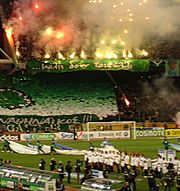
Panathinaikos was founded to spread football in Athens and connect with European football.
Today, Panathinaikos is the second most popular football team in Greece. They have a large fanbase in Athens, across Greece, in Cyprus, and among Greeks living abroad. Historically, they have been popular among highly educated people and also among middle and lower classes.
Panathinaikos supporters hold records for the most season tickets sold (31,091 in 2010) and the highest average attendance for a season (44,942 in 1985–86).
The main organized fan group is Gate 13, started in 1966. It's the oldest fan association in Greece and has about 80 clubs. Gate 13 fans use green fireworks, flags, banners, and create colorful displays. They are known for their loud and constant cheering. Gate 13 has become a big part of the club, influencing decisions and following the team everywhere.
Gate 13 fans have friendships with supporters of Hungarian club Ferencváros and Ultras Rapid Wien, mainly because of their shared green and white colors. They also have close ties with Dinamo Zagreb's Bad Blue Boys and Fedayin of A.S. Roma.
The Panathenaic Alliance, a group of fans, is the main shareholder of the football club. This makes Panathinaikos the only supporter-owned football club in Greece.
Club Records & Statistics

Mimis Domazos has played the most games for Panathinaikos, with 502 matches between 1959 and 1980. Striker Krzysztof Warzycha is second with 390 games. The record for a goalkeeper is held by Takis Ikonomopoulos, with 303 appearances.
Krzysztof Warzycha is the club's top goalscorer with 319 goals in all competitions from 1989 to 2004. He passed Antonis Antoniadis' record of 180 goals in 1998.
Panathinaikos' record for home attendance is 74,493. This was for a Greek League match against AEK Athens in 1986 at the Olympic Stadium. The record at the Leoforos Alexandras Stadium is 29,665 from a 1967 Cup Winners' Cup game.
Panathinaikos is one of only two clubs in Greek football history to finish a top-flight season (after 1959) without losing a game. This happened in the 1963–64 season.
|
League Top Scorers
|
Most League Appearances
|
Players Who Played for Only One Club
| Player | Nationality | Position | Debut | Last Match |
|---|---|---|---|---|
| Vangelis Panakis | FW | 1950 | 1965 | |
| Anthimos Kapsis | DF | 1969 | 1984 | |
| Giannis Goumas | DF | 1994 | 2009 | |
| Giannis Papantoniou | MF | 1945 | 1958 | |
| Frangiskos Sourpis | DF | 1962 | 1973 |
Top Scorers in Super League Seasons
| Rank. | Nationality | Player | Times | Seasons |
|---|---|---|---|---|
| 1 | Antonis Antoniadis | 5 (Greek record) | 1970, 1972, 1973, 1974, 1975 | |
| 2 | Krzysztof Warzycha | 3 | 1994, 1995, 1998 | |
| 3 | Djibril Cissé | 2 | 2010, 2011 | |
| 4 | Dimitris Saravakos | 1 | 1991 | |
| 5 | Nikos Liberopoulos | 2003 | ||
| 6 | Angelos Messaris | 1930 | ||
| 7 | Filippos Asimakopoulos | 1955 | ||
| 8 | Tasos Kritikos | 1936 | ||
| 9 | Marcus Berg | 2017 |
Most Goals in a Single Season
| Rank. | Nationality | Player | Goals | Season |
|---|---|---|---|---|
| 1 | Antonis Antoniadis | 39 goals (Greek record) | 1971–72 (also second in Europe, "Silver Boot") |
Top Scorers in European Competitions
Uefa Champions League
| Rank. | Nationality | Player | Times | Seasons |
|---|---|---|---|---|
| 1 | Antonis Antoniadis | 1 | 1970–71 |
UEFA Cup
| Rank. | Nationality | Player | Times | Seasons |
|---|---|---|---|---|
| 1 | Dimitris Saravakos | 1 | 1987–88 |
Team Records in Greece
| Outline | Record |
|---|---|
| Champions without a loss | 2 (1929–30, 1952–53) |
| Champions without a loss in a top-flight campaign (after 1959) | once (1963–64) |
| Biggest win in a Greek Super Cup match | 3–0 (vs AEK, 1994) |
Club Honours (Trophies)
| Type | Competition | Titles | Seasons |
|---|---|---|---|
| Domestic | Super League Greece | 20 |
1929–30, 1948–49, 1952–53, 1959–60, 1960–61, 1961–62, 1963–64, 1964–65, 1968–69, 1969–70, 1971–72, 1976–77, 1983–84, 1985–86, 1989–90, 1990–91, 1994–95, 1995–96, 2003–04, 2009–10 |
| Greek Football Cup | 20 |
1939–40, 1947–48, 1954–55, 1966–67, 1968–69, 1976–77, 1981–82, 1983–84, 1985–86, 1987–88, 1988–89, 1990–91, 1992–93, 1993–94, 1994–95, 2003–04, 2009–10, 2013–14, 2021–22, 2023–24 |
|
| Greek Super Cup | 3 | 1988, 1993, 1994 | |
| International | Balkans Cup | 1 |
1977 |
- record
- s shared record
Doubles (League & Cup Wins)
- Winners (8): 1968–69, 1976–77, 1983–84, 1985–86, 1990–91, 1994–95, 2003–04, 2009–10
Trebles (League, Cup & Balkans Cup Wins)
- Winners (1): 1976–77 (League, Greek Cup, Balkans Cup)
Regional Titles
- Athens FCA Championship
- Winners (17) (record): 1925, 1926, 1927, 1929, 1930, 1931, 1934, 1937, 1939, 1949, 1952, 1953, 1954, 1955, 1956, 1957, 1959
European & Worldwide Achievements
- UEFA Champions League
- Runners-up (1): 1971
- Semi-finals (2): 1985, 1996
- Quarter-finals (2): 1992, 2002
- UEFA Europa League
- Quarter-finals (2): 1988, 2003
- Balkans Cup
- Winners (1): 1977
Worldwide Competitions
- Intercontinental Cup
- Runners-up (1): 1971
Current Players
|
|
Panathinaikos Academy Players
|
Players Out on Loan
|
|
Other Players Under Contract
|
|
Retired Jersey Numbers
- 13 Gate 13 - This number is retired to honor the club's loyal fans.
- 32

 George Baldock, Defender (2024) – This number was retired in his memory after his passing.
George Baldock, Defender (2024) – This number was retired in his memory after his passing.
Former Players
Panathinaikos & the Greece National Team
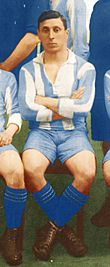
Panathinaikos has greatly contributed to the Greece national football team. Giorgos Kalafatis, the club's founder, played for Greece in the Inter-Allied Games in Paris and was a player/manager for Greece in the 1920 Olympic Games. Over the years, many top Greek players from Panathinaikos have played for the national team, including Domazos and Antoniadis.
Six Panathinaikos players were part of the first Greek team to play in a World Cup in 1994. Six players from the club were also on the famous team that won the UEFA Euro 2004 in 2004.
Club Staff
Technical Staff
| Position | Staff |
|---|---|
| Head coach | |
| Assistant head coach | |
| Fitness trainer | |
| Assistant fitness trainer | |
| Goalkeeper coach | |
| Analyst | |
| Rehabilitation trainer |
Club Management Staff
Club Leadership
| Position | Staff |
|---|---|
| Ownership | |
| President | |
| Vice-President | |
| Board member |
Images for kids
-
Stjepan Bobek, head coach (1963–67)
-
Ferenc Puskás, head coach (1970–74)
See also
 In Spanish: Panathinaikos Fútbol Club para niños
In Spanish: Panathinaikos Fútbol Club para niños
- Sports
- Panathinaikos A.O.
- Panathinaikos B
- Panathinaikos women's football
- Panathinaikos F.C. Academy
- Panathinaikos B.C.
- Panathinaikos women's basketball
- Panathinaikos V.C.
- Panathinaikos women's volleyball
- Other
- European Club Association
- List of unrelegated association football clubs


